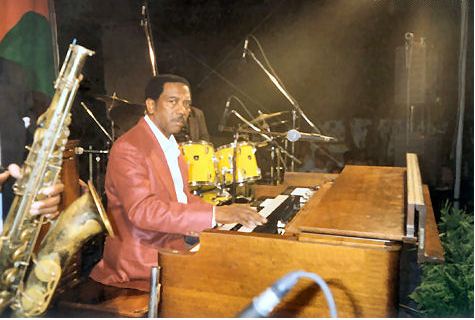Cultural origins 1950s | ||
 | ||
Stylistic origins Hard bop
jazz
soul
blues
rhythm and blues
gospel Typical instruments Hammond organ
piano
saxophone
guitar
double bass
electric bass
drums | ||
Soul jazz is a development of jazz incorporating strong influences from blues, soul, gospel and rhythm and blues in music for small groups, often an organ trio featuring a Hammond organ.
Contents
New soul jazz the sunday morning compilation
History
Soul jazz is often associated with hard bop. “Hard bop was an “opening out” in many directions." Mark C. Gridley, writing for the All Music Guide to Jazz, explains that soul jazz more specifically refers to music with "an earthy, bluesy melodic concept" and "repetitive, dance-like rhythms.... Note that some listeners make no distinction between 'soul-jazz" and 'funky hard bop,' and many musicians don't consider 'soul-jazz' to be continuous with 'hard bop.'" Roy Carr describes soul jazz as an outgrowth of hard bop, " and "soul" appearing in a jazz context as early as the mid-1950s to describe "gospel-informed, down-home, call-and-response blues." Carr also notes the acknowledged influence of Ray Charles' small group recordings (which included saxophonists David "Fathead" Newman and Hank Crawford) with Horace Silver, Art Blakey, Cannonball Adderley and Milt Jackson. The 1955–1965 years were a time of both consolidation and expansion yet the exact nature of those shifts in perspective among jazz musicians…too satisfied with defining the music by using such clichés as “soul,” “funk” and “returning to the roots.”
“F. Scott Fitzgerald famously dubbed the 1920’s the Jazz Age.” Soul jazz developed in the late 1950s, reaching public awareness with the release of The Cannonball Adderley Quintet in San Francisco. Cannonball Adderley noted: "We were pressured quite heavily by Riverside Records when they discovered there was a word called 'soul'. We became, from an image point of view, soul jazz artists. They kept promoting us that way and I kept deliberately fighting it, to the extent that it became a game." While soul jazz was most popular during the mid-to-late 1960s, many soul jazz performers, and elements of the music, remain popular. The Jazz Crusaders, for example, evolved from soul jazz to soul music, becoming The Crusaders in the process. Carr places David Sanborn and Maceo Parker in a line of alto saxophonists that includes Earl Bostic and Tab Smith, with Adderley, followed by Lou Donaldson, as the strongest links in the chain.
Some well-known soul jazz recordings are Curtis Fuller's Five Spot after Dark (1957), Lee Morgan's The Sidewinder (1963), Frank Foster's Samba Blues (1963), Herbie Hancock's "Cantaloupe Island" (1964) (which was popularized further when sampled by US3 on "Cantaloop (Flip Fantasia)" almost 30 years later, in 1993), Horace Silver's "Song for My Father" (1964), Ramsey Lewis's "The 'In' Crowd" (a top-five hit in 1965), and Cannonball Adderley's "Mercy, Mercy, Mercy" (1966) (also popularized further when covered as a top 40 pop song by The Buckinghams the following year). Les McCann and Eddie Harris's album Swiss Movement (1969) was a hit record, as was the accompanying single "Compared to What", with both selling millions of units.
Performers
Important soul jazz organists include Bill Doggett, Baby Face Willette, Jimmy Smith,Charles Earland, Richard "Groove" Holmes, "Brother" Jack McDuff, Jimmy McGriff, Lonnie Smith, Big John Patton, Freddie Roach, Larry Young, Don Patterson, Shirley Scott, Hank Marr, Reuben Wilson, and Johnny Hammond Smith.
Saxophone and guitar are also important in soul jazz; soul jazz tenors include Lou Donaldson, Stanley Turrentine, Hank Crawford, Gene Ammons, Eddie Harris, Houston Person, and Ramon Moris; guitarists include Grant Green, Melvin Sparks , O'donel Levy, Phil Upchurch, David T. Walker and George Benson. Other important players include pianist Horace Silver, Les McCann, cornet player Nat Adderley, torombone player Curtis Fuller, bassist Wilbur Bascomb, trumpetter Lee Morgan and drummer Idris Muhammad(Leo Morris), Les DeMerle, Paul Humphrey.
